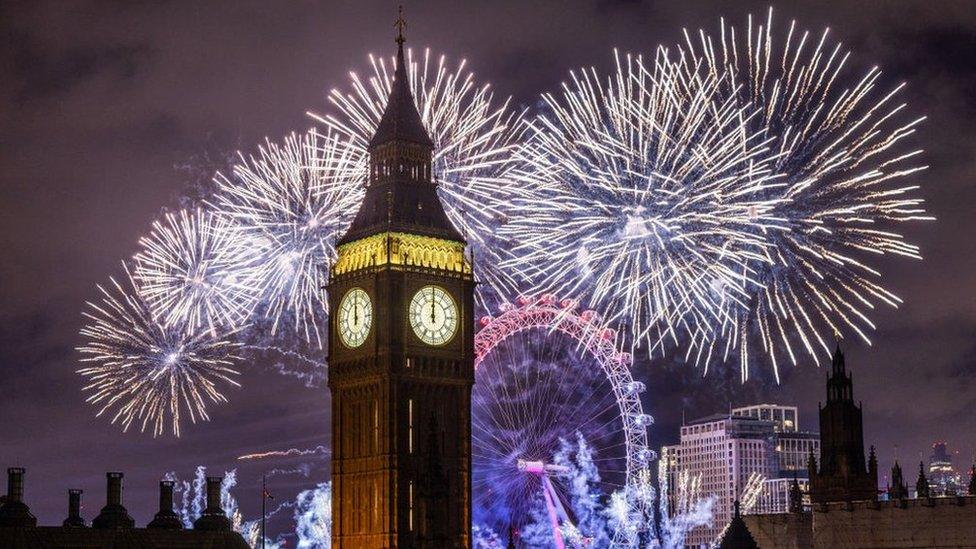How do fireworks work?
- Published
- comments

Every year people celebrate events like Bonfire Night, Diwali, Lunar New Year and New Year's Eve with colourful firework displays.
Fireworks have been around for thousands of years and come in all different shapes, sizes, sounds and colours.
They're made using a mixture of different types of metallic powders and chemicals, to make different colours and effects.
But how do fireworks actually work? Find out more below...
When were fireworks first discovered?
Thousands of years ago - around 200BC - 800 AD - Chinese alchemists - an early type of scientist - accidently created an early form of gunpowder.
It is believed, though no one knows for sure, that alchemists mixed together various chemicals and stuffed the mixture into old bamboo stalks. On catching fire the sticks exploded making a loud bang.
These were thought to be the first fireworks, or firecrackers.
Chinese people then used this invention to celebrate weddings, and scare away their enemies and evil spirits.
The reason why you can see a firework explode before you can hear the bang, is because light travels much faster than sound.
Sound travels at a speed of 761 mph, but light travels at a whopping 671,000,000 mph - so you may see it before you hear it!
Between the 1200AD and 1800AD gunpowder had begun to spread around the world, and was used by the military to make weapons, and also to create firework displays.
These displays were used to celebrate military victories, religious events or royal celebrations, but were only one colour - orange/gold, and were not very safe.
It wasn't until the 1830s that Italian inventors invented ways to mix in different metallic powders to create different coloured explosions.
They also came up with a special outer case which let them shoot fireworks into the air more safely.
How do fireworks work?
How are fireworks made, and how do they work?
There are lots of different types of firework, from rockets, to roman candles, fountains to catherine wheels and sparklers.
Each type of firework is built in a different way, with a different mix of chemicals to produce a unique effect when lit.
Firework rockets can reach speeds of 150 miles per hour (mph) when they are set off.
Rocket: When rocket-type fireworks are lit, the gunpowder explodes, creating gasses that shoot the firework into the air. When the firework reaches a certain height, another spark causes the 'stars' - little balls that are mixtures of metal powders - inside it to blow up creating a colourful explosion in the air.
Roman candles: These long tubes shoot balls of chemicals from one end, creating a series of flaming stars. Inside the tubes, the chemical balls are packed one on top of the other, with layers of sawdust between them.
Fountains: These are cone-shaped and sit on the ground. A hole in the top allows gases to escape, shooting coloured sparks into the air.
Smoke bombs: These fireworks create colourful smoke.
Sparklers: These are long pieces of wire that are coated in chemicals that give off bright sparkles of light when lit. Some sparklers can reach temperatures of 1000-1600 Celsius - that's around 15 times hotter than the boiling point of water! Sparklers have caused some of the most serious firework accidents.
Aerial shells: These are used in professional displays. They are the most spectacular and usually the loudest fireworks. They are placed in a long tube called a mortar pointing towards the sky and launched by an explosion which shoots them into the air.
Where do the colours come from in fireworks?
Fireworks get their colours from a chemical reaction that happens between mineral elements and oxygen in the air when they are heated.
Red is created by Strontium (Sr)
Orange is created by a mix of Strontium (Sr) and Sodium (Na)
Yellow is created by Sodium (Na)
Green is created by Barium (Ba)
Blue is created by Copper (Cu)
Purple is created by a mix of Strontium (Sr) and Copper (Cu)
Silver and White are created by Titanium (Ti), Zirconium (Zr), and Magnesium (Mg)
Gold is made by Iron (Fe) and small pieces of charcoal.
If you cannot see the interactive on this page, click .
- Published4 November 2022
- Published18 October 2011
- Published29 October 2019
